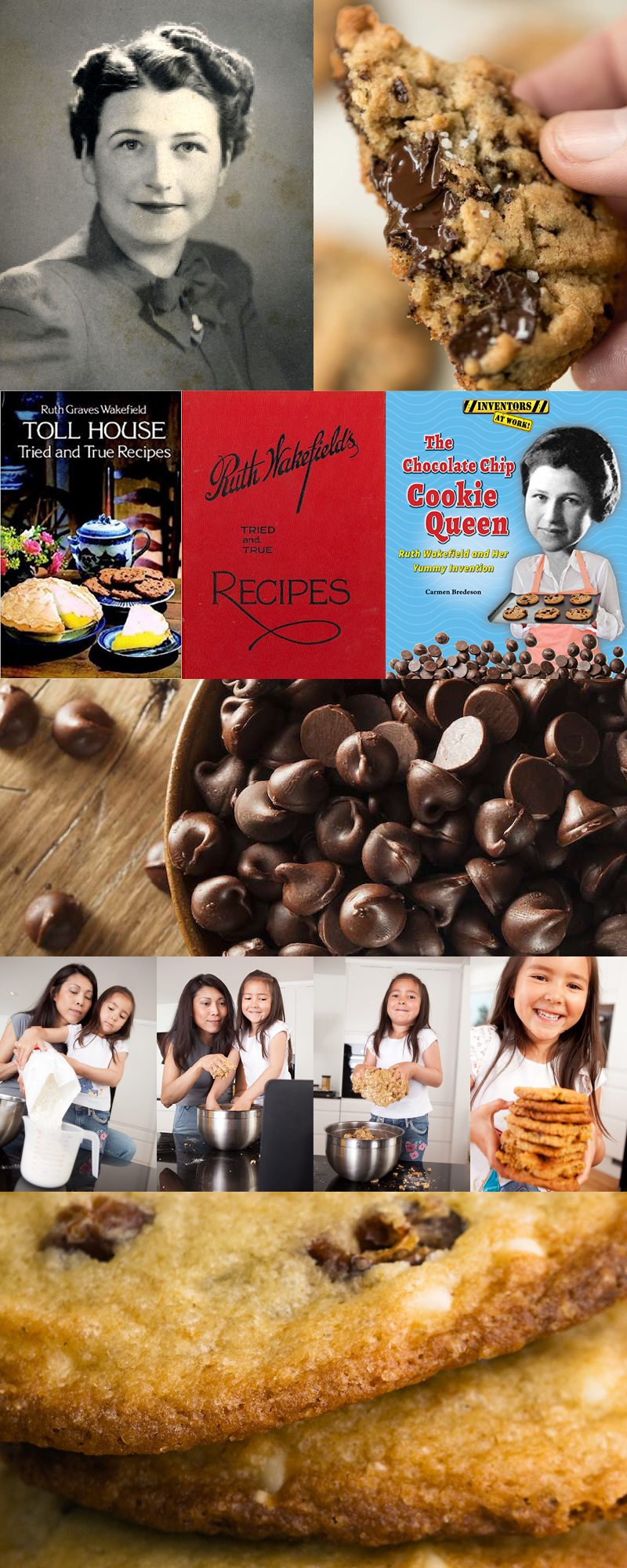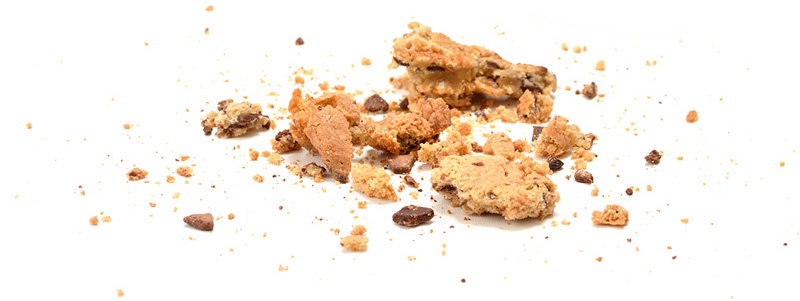You Can Taste It

(top row) Ruth Graves Wakefield and her cookie discovery. (row two) Find the current iteration of Ruth Wakefield’s wonderful recipe book on Amazon; Find a copy the original cookbook on Ebay; And this book celebrating Ruth’s invention of the chocolate chip cookie on Amazon. (the rest) I wonder how many thousands of kids have had their first taste (pun intended) of cooking by baking these cookies. Ahhhh, the smell that fills the house. Mmmm, the taste. Love it!!
Here at KHT, we’re all about recipe’s. Mixing ingredients, fine tuning temperatures, and even experimenting to find just the right balance for your PIA (Pain in the #%$) Jobs. We love it, and just can’t get enough “tinkering” time to make sure every single load comes out great. The other day I had a craving that I just had to follow – to get a tasty chocolate chip cookie. Immediately I thought of the special women in my life, and their recipes – grandma Kowalski, my amazing wife Jackie, and the girls. Each have their own way of mixing ingredients, baking and serving chocolate chip cookies … and I love every one of them!! (especially with vanilla ice cream and hot fudge! of course). Since Jackie’s chocolate chip cookies don’t last very long in our house, I really like to snitch from the mixing bowl before they go into the oven! It made me search out the history of this incredible invention, and that took me to Ruth Wakefield some 80 years ago this year. Enjoy, and thanks to Wikipedia and Jon Michaud from The New Yorker for the insights. And, if you have a “family favorite”, send me the recipe to post … or better yet, a fresh box to share with the KHT gang.
- The chocolate chip cookie was invented in 1938 by the American chef Ruth Graves Wakefield. She invented the recipe during the period when she owned the Toll House Inn, in Whitman, Massachusetts, a popular restaurant that featured home cooking and tasty deserts.
- Created as an accompaniment to ice cream, her chocolate-chip cookie quickly became so celebrated that Marjorie Husted (a.k.a. Betty Crocker) featured it on her radio program. On March 20, 1939, Wakefield gave Nestlé the right to use her cookie recipe and the Toll House name – for the price of one dollar – (a dollar that Wakefield later said she never received, though she was reportedly given free chocolate for life and was also paid by Nestlé for work as a consultant).
- It is often incorrectly reported that she accidentally developed the cookie, and that she expected the chocolate chunks would melt, making chocolate cookies. In fact, she stated that she deliberately invented the cookie. She said, “We had been serving a thin butterscotch nut cookie with ice cream. Everybody seemed to love it, but I was trying to give them something different. So, I came up with the Toll House cookie using chopped up bits from a Nestlé semi-sweet chocolate bar. (the original recipe is called “Toll House Chocolate Crunch Cookies.)
- Wakefield’s cookbook, Toll House Tried and True Recipes, was first published in 1936 by M. Barrows & Company, New York. The 1938 edition of the cookbook was the first to include the recipe “Toll House Chocolate Crunch Cookie” which rapidly became a favorite cookie in American homes.
- During WWII, soldiers from Massachusetts who were stationed overseas shared the cookies they received in care packages from back home with soldiers from other parts of the United States. Soon, hundreds of soldiers were writing home asking their families to send them some Toll House cookies, and Wakefield was soon inundated with letters from around the world requesting her recipe. Thus began the nationwide craze for the chocolate chip cookie.
- In the postwar years, the chocolate-chip cookie followed the path taken by many American culinary innovations: from homemade to mass-produced, from kitchen counter to factory floor, from fresh to franchised. In the nineteen-fifties, both Nestlé and Pillsbury began selling refrigerated chocolate-chip-cookie dough in supermarkets. Nabisco, meanwhile, launched Chips Ahoy in 1963, its line of packaged cookies.
- The Baby Boom generation, which had been raised on the Toll House cookie, sought to recapture the original taste of these homemade treats in stores that sold fresh-baked cookies. Famous Amos, Mrs. Fields, and David’s Cookies all opened their first stores in the seventies and prospered in the eighties. By the middle of that decade, there were more than twelve hundred cookie stands in business across the country.
- Every bag of Nestlé chocolate chips sold in North America has a variation (butter vs. margarine is now a stated option) of her original recipe printed on the back. The original recipe was passed down as follows:
- 1 1/2 cups (350 mL) shortening
- 1 1/8 cups (265 mL) sugar
- 1 1/8 cups (265 mL) brown sugar
- 3 eggs
- 1 1/2 teaspoon (7.5 g) salt
- 3 1/8 cups (750 mL) of flour
- 1 1/2 teaspoon (7.5 g) hot water
- 1 1/2 teaspoon (7.5 g) baking soda
- 1 1/2 teaspoon (7.5 g) vanilla
- chocolate chips – 2 bars (7 oz.) Nestlé’s yellow label chocolate, semi-sweet, cut in pieces the size of a pea.
- Although the Nestlé’s Toll House recipe is widely known, every brand of chocolate chips, or “semi-sweet chocolate morsels” in Nestlé parlance, sold in the U.S. and Canada bears a variant of the chocolate chip cookie recipe on its packaging. Almost all baking-oriented cookbooks will contain at least one type of recipe.
- Practically all commercial bakeries offer their own version of the cookie in packaged baked or ready-to-bake forms. National chains sell freshly baked chocolate chip cookies in shopping malls and standalone retail locations and several businesses offer freshly baked cookies to their patrons to differentiate themselves from their competition.
- There is an urban legend about Neiman Marcus’ chocolate chip cookie recipe that has gathered a great deal of popularity over the years. The legend claims Newman Marcus charged a customer $250 for the recipe, rather than the $2.50 she had expected.
- Depending on the ratio of ingredients and mixing and cooking times, some recipes are optimized to produce a softer, chewy style cookie while others will produce a crunchy/crispy style. Regardless of ingredients, the procedure for making the cookie is fairly consistent in all recipes.
- The texture of a chocolate chip cookie is largely dependent on its fat composition and the type of fat used. A study done by Kansas State University showed that carbohydrate based fat-replacers were more likely to bind more water, leaving less water available to aid in the spread of the cookie while baking. This resulted in softer, more cake-like cookies with less spread.
- Common variations include M&M’s (a “party” cookie), chocolate-chocolate chip using a chocolate flavored dough, using white chocolate, peanut butter chips or macadamia nuts, and replacing the dough with a flavored version, such as peanut butter. Other variations include using other types of chocolate, nuts or oatmeal. There are also vegan versions with ingredient substitutions such as vegan chocolate chips, vegan margarine, and so forth.
- Other taste variaitons include the Chipwich, the Taste of Nature Cookie Dough Bite, and the Pookie (a pie coated with chocolate-chip-cookie dough). Perhaps none of these variations was more culinarily or culturally significant than the début, in 1984, of Ben & Jerry’s Chocolate Chip Cookie Dough ice cream – it took them five years to find a way to mechanize the process of hand-mixing the frozen cookie dough with the ice cream, but it proved profitable. By 1991, Chocolate Chip Cookie Dough replaced Heath Bar Crunch as the company’s bestselling product.
- If you google chocolate chip cookies or best chocolate chip cookie recipes/cookbooks, you get hundreds of choices (I suggest you try them all!) One of my favorites is The Great American Chocolate Chip Cookie Book: Scrumptious Recipes & Fabled History From Toll House to Cookie Cake Pie, by Carolyn Wyman.
- To honor the cookie’s creation in the state, on July 9, 1997, Massachusetts designated the chocolate chip cookie as the Official State Cookie, after it was proposed by a third-grade class from Somerset, Massachusetts.
- Nowadays, we’d expect the inventor of such an iconic bit of Americana to publish an autobiography and make regular appearances on the Food Network, but Wakefield didn’t grandstand. She and her husband sold the restaurant, in 1967, and she passed in 1977. The original Toll House restaurant burned down spectacularly on New Year’s Eve in 1984 and the spot is now home to a Wendy’s. The authorities in Whitman required the fast-food restaurant include a small museum to Wakefield and the Toll House on its premises.




Leave a Reply
Want to join the discussion?Feel free to contribute!